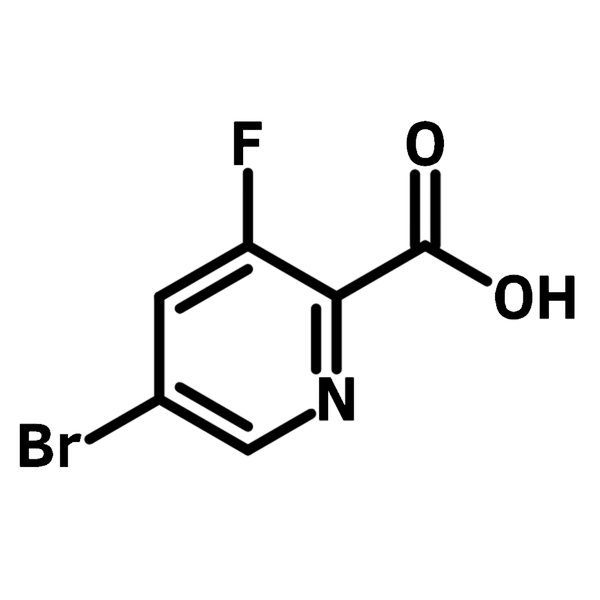5-Bromo-3-fluoropyridine-2-carboxylic acid
CAS Number 669066-91-5
Chemistry Building Blocks, Fluorinated Building Blocks, Heterocyclic Building Blocks, Materials, MonomersA fluorinated pyridinecarboxylic acid building block
As a synthesis intermediate for organometallic complexes used in catalysts and photoluminescent dyes
Specifications | MSDS | Literature and Reviews
5-Bromo-3-fluoropyridine-2-carboxylic acid (CAS number 669066-91-5), also referred to as 5-bromo-3-fluoropicolinic acid, is a dihalogenated picolinic acid. 5-Bromo-3-fluoropyridine-2-carboxylic acid can be used in the synthesis of allosteric adenosine A2A receptors for insomnia treatments.
5-Bromo-3-fluoropyridine-2-carboxylic acid is also utilised to prepare pyridine-triazole derivatives that coordinate to rhenium (Re) for photoluminescent materials. The reaction begins with the synthesis of pyridinehydrazide, followed by the formation of pyridine-oxadiazol using triethyl orthoformate. The resulting pyridine-oxadiazole then reacts with aniline derivatives to yield the pyridine-triazole ligands. The Re-pyridine-triazole complexes exhibit a photoluminescence quantum yield of up to 55%.
Multiple functional groups
For facile synthesis
Fluorinated picolinic acid building block
For catalysts, organometallic complexes, and photoluminescence dyes
Low Cost
Competitively priced, high quality product
High purity
>98% High purity
General Information
| CAS Number | 669066-91-5 |
| Chemical Formula | C6H3BrFNO2 |
| Full Name | 5-Bromo-3-fluoro-2-pyridinecarboxylic acid |
| Molecular Weight | 220.00 g/mol |
| Synonyms | 5-Bromo-3-fluoropicolinic acid, 5-Bromo-2-carboxy-3-fluoropyridine, 5-Bromo-3-fluoropyridin-2-carboxylic acid |
| Classification / Family | Fluorinated building blocks, Pyridine building blocks, Carboxylic acid building blocks, Organometallic complexes, Catalysts, Photoluminescence dyes |
Chemical Structure

Product Details
| Purity | 98% |
| Melting Point | Tm = 175 °C – 180 °C |
| Appearance | Off-white Powder |
MSDS Documentation
 5-Bromo-3-fluoropyridine-2-carboxylic acid MSDS Sheet
5-Bromo-3-fluoropyridine-2-carboxylic acid MSDS Sheet
Literature and Reviews
- Structural comparison of geometrical isomers of N’-(1H-imidazol-4-ylmethylene)picolinohydrazide and their mononuclear and dinuclear cobalt(III) complexes, D. Acheampong et al., Results Chem., 100798 (2023); DOI: 10.1016/j.rechem.2023.100798.
- Positive allosteric adenosine A2A receptor modulation suppresses insomnia associated with mania-and schizophrenia-like behaviors in mice, Y. Lin et al., Front. Pharmacol., 14, 1138666 (2023); DOI: 10.3389/fphar.2023.1138666.
- Tuning the photoluminescence properties of SLE- and MRL-active tricarbonylrhenium(I) complexes through minor structural changes of the organic ligand, A. Poirot et al., J. Photochem. Photobiol., A, 445, 114982 (2023); DOI: 10.1016/j.jphotochem.2023.114982.
